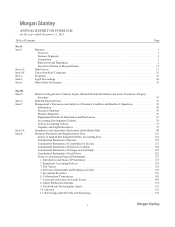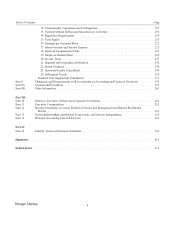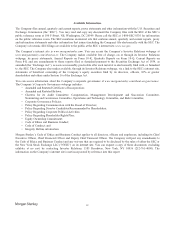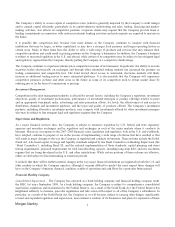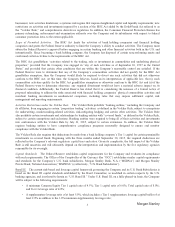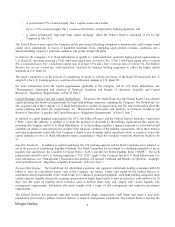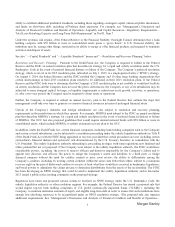Morgan Stanley 2015 Annual Report Download - page 11
Download and view the complete annual report
Please find page 11 of the 2015 Morgan Stanley annual report below. You can navigate through the pages in the report by either clicking on the pages listed below, or by using the keyword search tool below to find specific information within the annual report.
ability to establish additional prudential standards, including those regarding contingent capital, enhanced public disclosures,
and limits on short-term debt, including off-balance sheet exposures. For example, see “Management’s Discussion and
Analysis of Financial Condition and Results of Operation—Liquidity and Capital Resources—Regulatory Requirements—
Total Loss-Absorbing Capacity and Long-Term Debt Requirement” in Part II, Item 7.
Under the systemic risk regime, if the Federal Reserve or the Financial Stability Oversight Council determines that a bank
holding company with $50 billion or more in consolidated assets poses a “grave threat” to U.S. financial stability, the
institution may be, among other things, restricted in its ability to merge or offer financial products and required to terminate
activities and dispose of assets.
See also “—Capital Standards” and “—Liquidity Standards” herein and “—Resolution and Recovery Planning” below.
Resolution and Recovery Planning. Pursuant to the Dodd-Frank Act, the Company is required to submit to the Federal
Reserve and the FDIC an annual resolution plan that describes its strategy for a rapid and orderly resolution under the U.S.
Bankruptcy Code in the event of material financial distress or failure of the Company. The Company’s preferred resolution
strategy, which is set out in its 2015 resolution plan, submitted on July 1, 2015, is a single-point-of-entry (“SPOE”) strategy.
On August 5, 2014, the Federal Reserve and the FDIC notified the Company and 10 other large banking organizations that
certain shortcomings in their 2013 resolution plans needed to be addressed in their 2015 resolution plans. If the Federal
Reserve and the FDIC both were to determine that the Company’s 2015 resolution plan is not credible or would not facilitate
an orderly resolution and the Company does not cure the plan’s deficiencies, the Company or any of its subsidiaries may be
subjected to more stringent capital, leverage, or liquidity requirements or restrictions on its growth, activities, or operations,
or, after a two-year period, the Company may be required to divest assets or operations.
Further, the Company is required to submit an annual recovery plan to the Federal Reserve that outlines the steps that
management could take over time to generate or conserve financial resources in times of prolonged financial stress.
Certain of the Company’s domestic and foreign subsidiaries are also subject to resolution and recovery planning
requirements in the jurisdictions in which they operate. For example, MSBNA must submit to the FDIC an annual resolution
plan that describes MSBNA’s strategy for a rapid and orderly resolution in the event of material financial distress or failure
of MSBNA. The OCC has also proposed guidelines that would require insured national banks with $50 billion or more in
consolidated assets, which include MSBNA, to submit an annual recovery plan to the OCC.
In addition, under the Dodd-Frank Act, certain financial companies, including bank holding companies such as the Company
and certain covered subsidiaries, can be subjected to a resolution proceeding under the orderly liquidation authority in Title II
of the Dodd-Frank Act with the FDIC being appointed as receiver, provided that certain procedures are met, including certain
extraordinary financial distress and systematic risk determinations by the U.S. Treasury Secretary in consultation with the
U.S. President. The orderly liquidation authority rulemaking is proceeding in stages, with some regulations now finalized and
others planned but not yet proposed. If the Company were subject to the orderly liquidation authority, the FDIC would have
considerable powers, including: the power to remove officers and directors responsible for the Company’s failure and to
appoint new directors and officers; the power to assign the Company’s assets and liabilities to a third party or bridge
financial company without the need for creditor consent or prior court review; the ability to differentiate among the
Company’s creditors, including by treating certain creditors within the same class better than others, subject to a minimum
recovery right on the part of disfavored creditors to receive at least what they would have received in bankruptcy liquidation;
and broad powers to administer the claims process to determine distributions from the assets of the receivership. The FDIC
has been developing an SPOE strategy that could be used to implement the orderly liquidation authority and in December
2013 issued a public notice inviting comments on the proposed strategy.
Regulators have taken and proposed various actions to facilitate an SPOE strategy under the U.S. Bankruptcy Code, the
orderly liquidation authority or other resolution regimes. For example, the Federal Reserve has issued a proposed rule that
would require top-tier bank holding companies of U.S. global systemically important banks (“G-SIBs”), including the
Company, to maintain minimum amounts of equity and eligible long-term debt in order to ensure that such institutions have
enough loss-absorbing resources to be recapitalized under an SPOE resolution strategy. (The proposed rule also imposes
additional requirements. See “Management’s Discussion and Analysis of Financial Condition and Results of Operation—
5



